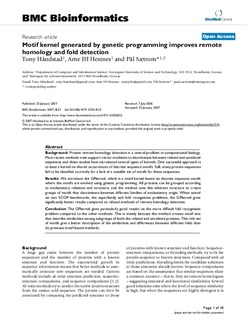| dc.contributor.author | Håndstad, Tony | |
| dc.contributor.author | Hestnes, Arne Johan Husebø | |
| dc.contributor.author | Sætrom, Pål | |
| dc.date.accessioned | 2015-09-21T11:26:45Z | |
| dc.date.accessioned | 2015-12-03T14:18:36Z | |
| dc.date.available | 2015-09-21T11:26:45Z | |
| dc.date.available | 2015-12-03T14:18:36Z | |
| dc.date.issued | 2007 | |
| dc.identifier.citation | BMC Bioinformatics 2007, 8 | nb_NO |
| dc.identifier.issn | 1471-2105 | |
| dc.identifier.uri | http://hdl.handle.net/11250/2366770 | |
| dc.description.abstract | Background: Protein remote homology detection is a central problem in computational biology.
Most recent methods train support vector machines to discriminate between related and unrelated
sequences and these studies have introduced several types of kernels. One successful approach is
to base a kernel on shared occurrences of discrete sequence motifs. Still, many protein sequences
fail to be classified correctly for a lack of a suitable set of motifs for these sequences.
Results: We introduce the GPkernel, which is a motif kernel based on discrete sequence motifs
where the motifs are evolved using genetic programming. All proteins can be grouped according
to evolutionary relations and structure, and the method uses this inherent structure to create
groups of motifs that discriminate between different families of evolutionary origin. When tested
on two SCOP benchmarks, the superfamily and fold recognition problems, the GPkernel gives
significantly better results compared to related methods of remote homology detection.
Conclusion: The GPkernel gives particularly good results on the more difficult fold recognition
problem compared to the other methods. This is mainly because the method creates motif sets
that describe similarities among subgroups of both the related and unrelated proteins. This rich set
of motifs give a better description of the similarities and differences between different folds than
do previous motif-based methods. | nb_NO |
| dc.language.iso | eng | nb_NO |
| dc.publisher | BioMed Central | nb_NO |
| dc.title | Motif kernel generated by genetic programming improves remote homology and fold detection | nb_NO |
| dc.type | Journal article | nb_NO |
| dc.type | Peer reviewed | en_GB |
| dc.date.updated | 2015-09-21T11:26:45Z | |
| dc.source.volume | 8 | nb_NO |
| dc.source.journal | BMC Bioinformatics | nb_NO |
| dc.identifier.doi | 10.1186/1471-2105-8-23 | |
| dc.identifier.cristin | 372679 | |
| dc.description.localcode | © 2007 Håndstad et al; licensee BioMed Central Ltd. This is an Open Access article distributed under the terms of the Creative Commons Attribution License (http://creativecommons.org/licenses/by/2.0), which permits unrestricted use, distribution, and reproduction in any medium, provided the original work is properly cited. | nb_NO |
